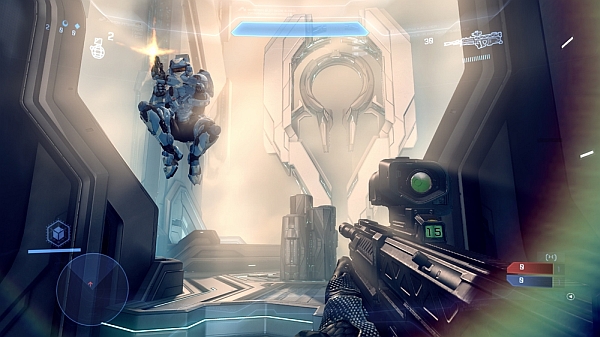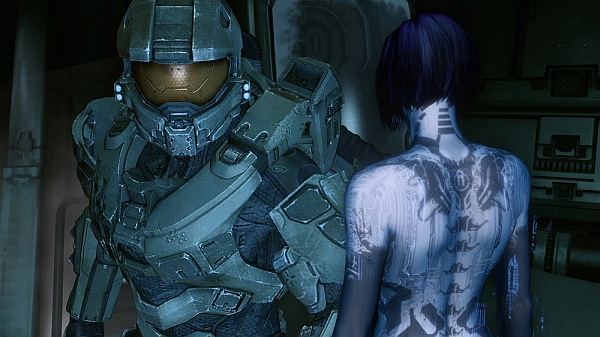
The Chief is back, baby – and better than ever. Remember those initial concerns when Bungie handed the Halo franchise over to Microsoft and its internal 343 Industries studio? Well, you can relax: the series is in very good hands. Halo 4 is by far the best of the bunch, surpassing even Bungie’s pinnacle swansong, Halo: Reach.
Platforms: Xbox 360
Publisher: Microsoft Studios
Developer: 343 Industries
Genre: First “in a New Trilogy” Person Shooter
Release Date: November 6, 2012
ESRB Rating: Mature
Change is never easy, but in this case, change is good. This is especially true of the story, which is the most personal and intimate of the series, as it focuses on the unique bond between the Chief and Cortana. AI’s have a seven-year lifespan, but Cortana has been in service for eight, and is beginning to deteriorate at an unnervingly rapid pace. Her struggle to maintain her sanity as she faces her own mortality is a very emotional journey, made even more touching as the Chief can do little but watch helplessly. Of course, there is a slim chance he can save her, but the Didact, a new evil bad guy bent on destroying humanity, stands in his way.
Naturally, Master Chief is up to the task and happily blasts his way through familiar Covenant enemies and the deadly new Prometheans. Crawlers are the Promethean equivalent of Grunts, except they’re much faster, charge at you like a pack of wild dogs, and can walk on walls and ceilings, allowing them to shoot you from all angles. The annoying flying Watchers can heal, protect, and revive their comrades, so it’s very important to take these out as quickly as possible. And the powerful Knights are not only tough to take down, but they also have the ability to teleport short distances – including a devastating in-your-face ramming attack. Ouch.
To help you take on the new baddies, the Armor Abilities from Halo: Reach return, including Active Camouflage, Hologram, and the always fun Jet Pack (Sprint is now a standard ability, so you don’t need anything special to use it). New abilities include the Hardlight Shield (a shield made of light that is, you know, hard), Promethean Vision (which highlights enemies similar to Batman’s detective vision) and the awesome Autosentry, a floating automated gun turret that is invaluable for crowd control and in chokepoints.
All of your favorite human and Covenant weapons return, along with powerful new Promethean equivalents – which, by the way, have the coolest reload animations you’ll ever see.

Gameplay pretty much follows the same formula as the previous editions, with plenty of on-foot shooting mixed with vehicle combat. Yes, the obligatory tank mission is there, along with a few new vehicles – including the Pelican (finally!). There is even a mission that will remind you of the thrilling flying-into-the-Death-Star sequence from Return of the Jedi.
Maps are big and open, with plenty of room to move around and flank enemies (or, if you’re not paying attention, enemies could flank you). Gameplay and movement is a little bit faster, there are more enemies onscreen, and the Chief is a bit more grounded (his jump is far less “floaty”). It is yet another incremental evolution, which isn’t necessarily a bad thing, but there are still moments when you get a feeling of same ol’, same ol’. It feels like 343 wanted to ease fans into their interpretation of a Halo game and so kept much of the same elements, but you can see where they want to take the gameplay into a new, faster-paced, high-octane direction. Let’s hope they get bolder in that regard with Halo 5.
For example, what really sets Halo 4 apart from the previous editions are the significantly upgraded audio effects. Halo guns have always sounded wimpy and a bit cartoony, but not anymore. Human weapons now pack a powerful, sub-woofer-busting punch, and alien guns sound much more deadly. As Call of Duty fans know, loud, explosive weapons fire greatly enhances the excitement and danger of combat, and it’s a joy to see this added to the Halo universe.
And it’s not only the weapons that sound better: Covenant Grunts no longer make comical, Ewok-like cries, and instead hiss menacingly. Elites now sound like the scary monsters they should be. Even the vehicles have been given an ear-pleasing boost, making them sound more solid and realistic. Overall, the auditory upgrades greatly complement and enhance the gameplay.
Except, perhaps, for the music. Don’t get me wrong, Neil Davidge’s soundtrack is great, but it just doesn’t have that special Martin O’Donnell magic. Marty’s sweeping, iconic scores have become instant classics and are as integral to the franchise as Master Chief himself, which makes it extremely tough for any new composer to follow in his footsteps. Imagine Star Wars without John Williams and you get the idea. Davidge does an admirable job, but it doesn’t quite feel like Halo. Maybe it’s an unfair comparison, but it’s worth noting.

Halo 4 is the most expensive game Microsoft has ever made, and it shows. The cutscenes are stunning, with the most realistic looking faces and facial animation since LA Noire. In game, the graphics are simply the most beautiful and detailed ever in the series, with large open maps, nasty-looking enemies, and highly detailed weapons.
Adding to the spectacle (and cost) is the new Spartan Ops co-operative game mode. Spread out over a five-chapter “season,” each chapter is made up of five episodes that extend the campaign story. You and up to three friends play as a squad of Spartans tasked with several objectives on a variety of maps, but basically, you just kill everything that moves. Each chapter begins with an impressive and extensive cutscene, with plans to release new chapters weekly. The first season is free, but you’ll have to pay for future seasons.
Spartan Ops replaces the previous Firefight mode from Reach, and feels like a condensed mini-campaign. You can play it solo, but needless to say, it’s a lot more fun with friends. Unlike Firefight, weapons are a bit more plentiful, the maps are larger, and there are plenty of vehicles available. Spartan Ops is a blast, especially with the additional story elements that build up the anticipation for the next chapter, but I kind of miss the mindless arena battles of Firefight. Still, if you love co-operative battles, Spartan Ops is an interesting new take on the genre.
The big draw, of course, is Halo’s coveted multiplayer, and it doesn’t disappoint. Gameplay is still the same run-and-gun mayhem we all know and love, with new tweaks that up the addictiveness. For example, there is a new RPG-like leveling system that unlocks new weapons, Armor Abilities, modifiers like faster shield regeneration or expanded radar, and of course, tons of armor pieces to customize your character’s appearance. You can also unlock new Specializations that add additional modifiers like increased vehicle durability or highlighting the meanie who just killed you. Racking up several kills in a row enables an Ordnance Drop, which pops up a menu of three randomly selected weapons; pick one and it will be instantly delivered via an orbital drop pod. Be careful, though, because anyone (including the opposing team) can grab it. The leveling system adds a never-ending “Oh, I’m so close to unlocking X” layer on top of Halo’s already addictive multiplayer, so you can pretty much say goodbye to any spare time you may have.
All of your favorite gametypes are included, and they are as fun as ever. The maps are superbly designed as you might expect, ranging from small, tight maps encouraging close-quarters combat, to huge vehicle-friendly battlefields. Halo’s industry-leading matchmaking system is still the best, and will put you into games quickly and painlessly.
So yes, 343 has done the impossible and surpassed even the toughest fans’ expectations. The franchise is in good hands and I can’t wait for the sequel. The changes from Bungie aren’t radical, but significant enough to mark a new direction for both the story and gameplay. Things are looking up for the Chief and his fans.

Review Disclosure: A retail copy of Halo 4 was purchased by Warp Zoned for the purposes of this review.







